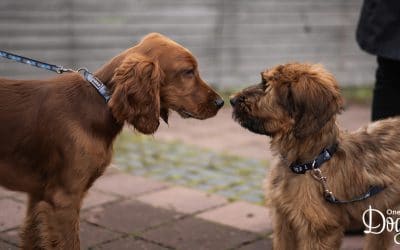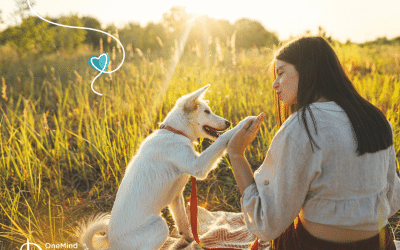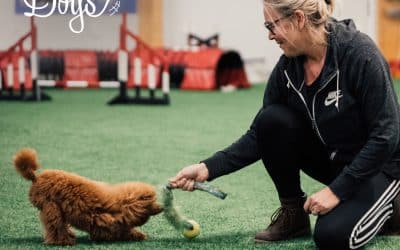Training a puppy can be a challenging and, let’s face it, sometimes overwhelming task. No matter how much love and attention we give them, puppies can be quite a handful.
But what if we could prevent puppy problems before they even begin? Instead of dealing with the consequences when they misbehave, why not teach them how we want them to behave in the first place? No dog is a naughty puppy on purpose; they just need guidance and understanding from their owners.
The OneMind Dogs puppy program is designed to provide easy-to-follow lessons that set your puppy up for success, helping you create the puppy of your dreams. In this blog post, we’ll discuss proactive training techniques that will strengthen your bond with your dog and help prevent common issues from becoming significant problems later on.
You can also download our free guide: 10 tips to a successful first week with your new puppy
Preventing puppy problems
Every puppy comes with its own set of quirks, and some respond to training more easily than others. As the saying goes, prevention is better than cure, which couldn’t be more accurate regarding puppy training. The good news is, we’re here for the shy pups, the boisterous, the stubborn, and the wild ones. And, of course, we’re here for you.
Here are some common problems you can prevent through proactive puppy training:
Housetraining
One of the first tasks you’ll focus on as a new puppy parent is housetraining. After all, no one enjoys stepping in a puppy surprise! To effectively housetrain your puppy, keep these key points in mind:
- Consistency: Establish a routine for sleeping, playtime, and potty breaks. This helps your puppy understand when and where they’re expected to go.
- Supervision: Watch your puppy closely for signs they need to go, such as sniffing or circling. Take them outside immediately to avoid accidents. If there is an accident, don’t scold them! Remind yourself that you need to supervise more closely
- Praise and reward: Celebrate successes with praise and treats to reinforce good behavior immediately after the puppy has finished toileting.
If your puppy is struggling with housetraining, try crate training or using puppy pads to provide a designated area for them to go. Or use a puppy pen to confine them when you are not able to be supervising closely. Puppies can hold their bladders for 1 hour for every month of their age. So for example, a 4 month old puppy can generally “hold it” for 4 hours before they become uncomfortable.
Keep a consistent schedule and avoid changing types of food, as this can cause digestive system disruptions and make housetraining more difficult.
Training your puppy to stop biting or chewing
They don’t call puppies “land sharks” for nothing. Young dogs are notorious for their razor-sharp teeth and fondness for exploring the world with theit mouths. While this behavior is natural for young dogs, it’s essential to teach them that biting people and furniture is not acceptable.
To prevent biting, start by providing appropriate chew toys. Offer a variety of safe, durable toys for your pup to chew on instead of your possessions.
When they inevitably steer away from the toys, you may use redirection. When you notice your puppy intends to bite the wrong object (or person,) redirect their attention to a toy or treat. If your puppy is getting snarky with you while biting, try giving them a rest in their bed or puppy pen as they may be over tired.
You can also encourage gentle play with you by stopping interactions if your puppy bites too hard. Say “ouch” in a high-pitch voice and stand up, turning away from your puppy for a minute or two. Resume play once your puppy calms down. Your puppy will quickly learn that biting means the fun stops.
It’s also important to understand the world from your dog’s point of view. They explore the world with their mouths, so providing plenty of opportunities for appropriate chewing and mouthing can help satisfy their natural curiosity. Introducing puzzle toys and interactive games can also help curb unwanted biting behavior by keeping your pup mentally stimulated and engaged.
Guarding behavior
Resource guarding is a natural instinct in dogs. They may guard their food, toys, bed, or even people. It is important to teach your puppy good habits around these items, as guarding behavior can be dangerous if not addressed early on. To prevent guarding behavior, make sure you don’t skip these essential puppy training steps:
- Establish trust: Show your puppy that you’re not a threat by offering treats and toys without taking anything away.
- Practice trading: Exchange one valuable item for another to teach your pup that giving up resources can be rewarding.
- Avoid punishment: Scolding or punishing your dog for guarding may increase their anxiety and worsen the problem.
One way to address potential guarding behavior is by hand-feeding your puppy during the early stages of its life. This helps create a positive association between your presence and their resources, reducing the likelihood of future guarding issues. It’s also a great opportunity to turn daily interactions with your dog into learning opportunities!
Travelling by car
What’s worse than two kids asking, “Are we there yet?” every two minutes? A puppy asking the same thing, only not in words! Regular car trips with your puppy can be a great opportunity to get them used to being in a moving vehicle, something which will come in handy when it’s time for trips to the vet. However, you’ll need to ensure they are secure and not jumping or running around while driving. Training your puppy to love the car make everyday life much easier!
A noisy or restless puppy can be a dangerous distraction while driving, so aim to make car rides comfortable and stress-free. Here are some tips to ease your pup into car travel:
- Start slowly: Introduce your puppy to the car by sitting in it with them while it’s parked, gradually working up to short drives. You can even feed them meals in a stationary car a few times!
- Secure your pup: Use a crate or pet safety harness to keep your dog safe during car rides.
- Bring familiar items: Pack a blanket, a toy, or a treat your puppy associates with comfort to help them feel more at ease.
- Keep it positive: Don’t make the first car trip a drive to the vet for needles! Take lots of short, fun car trips to things like the park or a friend’s place
These tips will help create positive associations with car rides and make them more enjoyable for both you and your pup. Instead of coaxing your dog into the car every time you need to take them somework, be proactive and tecah them that the car is a source of fun and adventures!
Walking nicely on the leash
We always recommend that our clients practice basic leash walking before venturing into the world. Teaching your puppy early on to enjoy being on a leash and walking nicely by your side will make life much easier down the road. Honestly, they probably won’t like it at first. But can you blame them? The exciting smells, the people walking by, the birds up above. It’s sensory overload!
Here’s how to avoid dealing with a wiggly, escape-artist ninja everytime your puppy sees a leash:
First, you have to choose the right equipment. Use a sturdy, comfortable leash and a good quality harness that fits your puppy comfortably and allows for free movement. A flimsy leash will not offer enough safety, and a collar is easy to escape from could put too much pressure on your puppy’s neck.
Second, practice making walking fun by rewarding good behavior. That means praising and handing them a treat when they walk without pulling or lunging (this is a great opportunity to feed their daily meals from a treat pouch). Be patient in the early days. Leash training takes time and practice, so stay consistent and keep sessions short and positive.
Introducing loose-leash walking techniques, such as changing direction when your puppy pulls and praising and rewarding when they don’t pull, can help teach them that pulling doesn’t get them where they want to go. Additionally, practicing attention exercises like having your puppy make eye contact with you before continuing on your walk can strengthen your bond and improve leash manners.
Training you puppy to be happy alone
The unfortunate reality is that as much as you may want to stare at that chubby belly and cute face all day, that’s not always possible. You might have a job, familial obligations, or errands to run. Your pup won’t want to be alone at first and might even suffer from separation anxiety. But with gradual training, they can learn to be comfortable when you’re away.
The OneMind Dogs puppy program has lessons covering this topic, which can help you and your pup get on the path to helping them understand that being alone is not bad.
- Gradually increase the duration: Start by leaving your puppy alone for a few minutes, then gradually lengthen the time spent apart.
- Offer distractions: Provide toys, puzzles, or treats to help occupy your pup while you’re away.
- Establish a routine: Set a consistent schedule for departures and arrivals to help your puppy understand when they can expect you to return.
- Get your puppy used to a puppy pen from day 1: By feeding meals and providing toys in a comfortable puppy pen, your puppy will get used to that being their safe space. Start leaving them in there for short periods of time while you are home and gradually build those up. This way, it won’t be such a shock when you suddenly leave them alone.
Creating a safe, comfortable space for your puppy to relax while you’re gone can also help ease separation anxiety. Consider setting up a designated pen or room with their bed, toys, and water that they can call their own if you haven’t done so already.
Trimming your puppy’s nails
Regular “pawdicures” are essential for your pup’s health but can be stressful for both of you. Turn nail trimming into a positive experience by handling your puppy’s paws regularly from the first day at home. Gently touch and hold your pup’s paws while praising and feeding treats to help them become accustomed to being handled.
As for the big scary clippers, let your puppy sniff and investigate the nail trimmers a few times before using them. Of course, reward their cooperation during clipping and at the end. Praise and treat your dog during and after each successful nail trim.
To further ease the stress of nail trimming, consider introducing a nail grinder rather than traditional clippers. Nail grinders create less noise and pressure on the nail, making the process more comfortable for sensitive pups.
Being handled by people
Your puppy will need to be handled by various people throughout their life, from veterinarians to groomers. Sure, your pup may love belly rubs. But it might be a different story when the groomer tries to remove that grimy mud from those tiny paws or your vet has to give your puppy a vaccination.
Consistent handling and positive reinforcement can help your puppy become more comfortable with various types of touch, making future grooming and veterinary visits less stressful. Remember that each puppy is unique, so be patient and adjust your approach based on your pup’s individual needs and reactions. Make sure that you handle the sensitive parts of your puppy (ears, paws, tail, mouth) gently every day, praising and rewarding your puppy while you do so.
Download Our app today
Proactive puppy training is essential for preventing problem behaviors and setting your dog up for success. By subscribing to OneMind Dogs and downloading the app, you’ll gain access to valuable resources and guidance to help you raise a well-adjusted, happy pup. So why wait? Start your proactive training journey today and enjoy a lifetime of companionship with the puppy of your dreams.



